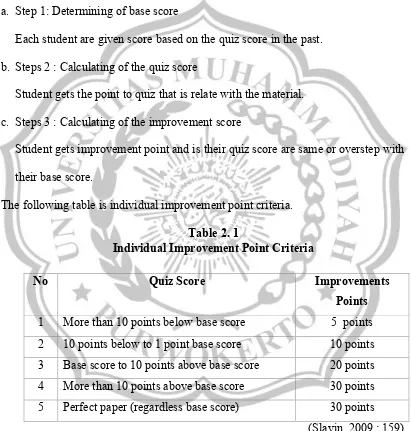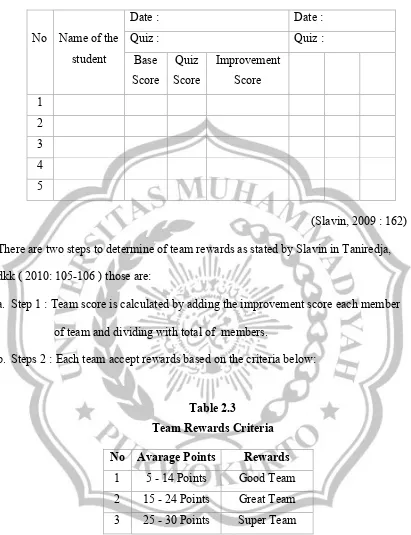CHAPTER II THEORITICAL REVIEW
A. Reading
1. The Importance of Reading
Reading is one of the important aspect for the students, especially in
English. From reading the students can get many information and
knowledge. There are many books to support their reading habit therefore,
some of the students will feel difficulty to understand of the books, etc that
are written in English. Ramelan (1990: i) stated that :
“ Reading plays very important parts in our life. Through reading we can
explore the world, countries that have never been visited before, and the
minds and ideas of great people in the past, all of which will enrich our
experience and knowledge and broaden our horizon. To a student, reading is
also something crucial and indispensable since the success of their study
depends for the greater part on his ability to read. If their reading skill is
poor they are very likely to fail in their study or at least they will have
difficulty making progress. On other hand, if he or she has a good reading
ability, he or she will have a better chance to succeed in their study.
As the students who study English lesson, reading is one of the
important skills, because the students will explore many information,
knowledge from reading activity. Besides that, it can give more
2. The purpose of Reading
The purpose of reading is looking for and getting information from
books, references, texts or others. By reading, students are able to explore
their knowledge well.According to Anderson (1972: 10) there are some
purpose of reading, those are :
a. Reading for details or fact
The students read the text to get detail information of text or know the
inversion that have been done by the writer or solve the problem of the
writer.
b. Reading for main idea
The students read the text (books) to know why the topic is good or
interesting, find the problems on the passage and make summaries of the
passage.
c. Reading for sequence or organization
The students read the text to know what is happening in each part of the
passage in every episode and solve the problem of the text.
d. Reading for inference
The students read the text in order to find out the conclusion from the
action or idea in the text.
e. Reading to classify
The students read the text to classify some information or actions of the
f. Reading to evaluate
The students read the text to find out the characteristic of each character
then evaluate them, either the character can be imitated or not and the
student tries to evaluate the writer has done or what he tries to explain or
contrast.
g. Reading to compare or contrast
The students read to compare the plot of the text or content that having
similarity with the readers or even contrast.
3. Recount text
Recount is a text to inform or to tell past events or past experiences. Recount
text uses simple past tense.
The generic structures of text recount are : orientation, events and
reorientation or concluding statement of the story.
a. The orientation tells the readers who was involved in the story, what
happened, where the story took place, and when it happened.
b. The events tell the series of events. These events are described in order
that happened in the past.
c. The reorientation summaries the events. It is optional. It can be available
or unavailable.
Toni was at the railway station in Jakarta yesterday. He was
waiting for the train. He was going to spend the holiday
with his uncle in Surabaya.
Orientation
The train had just arrived. Many passengers were getting on
the train. Toni was getting on too.
Event 1
check Toni's ticket. Toni gave him the ticket, and the
conductor punched a hole in it.
At last the train arrived in Surabaya. Toni saw his uncle and
cousin. They had to meet him. Toni waved to them and got
off. He was very happy.
Reorientation
B. Cooperative Learning
1. The Elements of Cooperative Learning
Cooperative learning have some elementsRoger & David Johnson in
Lie (2008: 31-35) proposed five elements of cooperative learning to get the
maximal result, those are :
a. Positive Dependence
The students help and motivate each other in their team in understanding
material and doing exercises. So, there is an interaction among students.
b. Individual Responsibility
The students will feel responsibility to do the best. It means that, each
member of the teams have to do responsibility themselves to improve
their knowledge. The responsibility not only to themselves but also to
their team.
c. Face to Face
Each teams are given opportunity to meet (face to face) and discussion.
The members of teams should be given opportunity to recognize and
accept another members in face to face and personal activity. It will
d. Communication
This element requires students to be given communication skill. Before,
the teacher assigns students in group. The teacher should teach how to
communicate, because not each students have listening and speaking
skills. The success of a team depends on the willingness of the members
to listen and their ability to present their opinion.
e. Evaluation of Group Processinng
In cooperative learning, teacher gives opportunity for teams to evaluate
the result of their work, cooperation of the team, their skills.
2. Kinds of cooperative learning
a. Student Team Achievement Division (STAD)
b. Jigsaw
c. Group Investigation
d. Think Pair Share
e. Numbered Head Together (NHT)
f. There Step Interview
g. Pairs Check
h. Send A Problem
i. Round Table
3. Student Team Achievement Division (STAD)
a. Division :
using small groups, each group consists of 4-5 students heteregonely. It
is begun of the learning purpose, delivery of the material, group activty,
quizz and team reward. According to Slavin in Nur (2000 : 26) stated
that in STAD, students are assigned in groups work, each group consists
of 4-5 students that mixed in performance level, gender ethnicity. The
teacher presents the lesson, then the students work within their teams to
make sure all team members have mastered the lesson. Then, all students
take individual quizes on the material at which time they may not
cooperate with another.
b. Advantages
The students actively help and support the spirit to succeed together.
The students cooperate in achieving the goal by considering the
norms of the group.
The students actively role as tutor to increase the team success.
Interactions of the intern-students improve along with the
improvement of the competence in giving ideas.
c. Disadvantages
Viewed from the class means to regulate the students for group work
is very time consuming.
A large number of students in each class, causing less than (he
maximum teacher in observing and learning activities both on a
group or individual.
learning to do, e. g, correcting student work, calculate the average
score of the group.
Require a lot of time and expense in preparing and implementing
learning.
C. Teaching Reading Through STAD Technique
Reading is one of the important things in learning English. It is support
the teaching learning skills (speaking, reading, writing and listening). So, the
students have to develop their understanding to find information and knowledge
from the reading text.
There are some procedures of STAD technique in teaching learning
process, especially in reading material, those are :
a. Pre test
In this step teacher gives the students pre test to rank from top to bottom.
b. Divide
Teacher divides students so that each team has high, low and middle ability
students and groups are diverse as to gender and ethnicity .
c. Present
Teacher presents the content or material of recount text
d. Distribute
After the teacher presents the material, then distributes work sheet that focus
on the content/ material to be learned.
f. Administer
After monitor, the teacher administers individual quizzes to student
g. A sign
The teacher sign team scores on individual gained scores.
h. Give reward
i. At the last step the teacher give reward as a team recognition : Good Team,
Great Team, and Super Team.
Here are steps of the improvement point as stated by Slavin (1995):
a. Step 1: Determining of base score
Each student are given score based on the quiz score in the past.
b. Steps 2 : Calculating of the quiz score
Student gets the point to quiz that is relate with the material.
c. Steps 3 : Calculating of the improvement score
Student gets improvement point and is their quiz score are same or overstep with
their base score.
The following table is individual improvement point criteria.
Table 2. 1
Individual Improvement Point Criteria
No Quiz Score Improvements
Points
1 More than 10 points below base score 5 points
2 10 points below to 1 point base score 10 points
3 Base score to 10 points above base score 20 points
4 More than 10 points above base score 30 points
5 Perfect paper (regardless base score) 30 points
Whereas, Scoring sheet of quiz can be seen in the following table:
There are two steps to determine of team rewards as stated by Slavin in Taniredja,
dkk ( 2010: 105-106 ) those are:
a. Step 1 : Team score is calculated by adding the improvement score each member
of team and dividing with total of members.
b. Steps 2 : Each team accept rewards based on the criteria below:
D. Students Team Achivement Division technique (STAD)
Students Team Achivement Division is one of the cooperative learning
technique by using small groups, each group consists of 4-5 students
heterogonely. It is begun of the learning purpose, delivers of material, group
activty, quizz and team reward. According to Slavin in Nur (2000 : 26) stated
that in STAD, students are assigned in groups work, each group consists of 4 - 5
students that mixed in performance level, gender ethnicity.
1. The teacher presents the lesson.
2. The students work within their teams to make sure all team members have
mastered the lesson.
3. All students take individual quizes on the material at which time they may
not cooperate with another.
E. Basic Assumption
The students felt that reading difficult lesson for them. Besides that, they
have a notion that reading was very boring. So, to avoid those poblems the
teacher used cooperative learning type STAD to teach reading because
cooperative learning type STAD could make students more active and they felt
more comfortable to study. So, The researcher assumed that STAD helped the
teacher to give comfortable atmosphere for his or her students and it can increase

